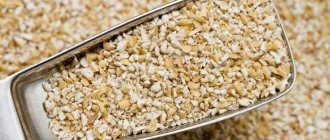© IgorVetushko — depositphotos.com
Share:
Finding effective diets for weight loss is a favorite pastime of all housewives. However, the approach in the spirit of “what should I eat to lose weight” does not always justify itself. Moreover, many advertised diets are dangerous to health.
Often things reach the point of absurdity when home-grown “nutritionists” take the principle of sports nutrition with “vigorous” modifications and pass it off as a complete and extremely effective weight loss system. This is exactly the fate that befell the BUTCH diet, which was not originally intended for the general public.
What is BUCH?
Before describing the principles of nutrition, the dangers and benefits of this method, we will answer the question, what is BEAM?
The abbreviation BUC stands for protein-carbohydrate alternation. This is not even a diet, but a way of eating based on the basic principles of rational calorie consumption and calculating BZH using periodization. If you add the word “diet” to this, you get a substitution of concepts. When people talk about the BUT diet, they mean an extremely small part of the principle of periodization of nutrition, which is not effective enough compared to the general principles. In addition, the main task of alternation is not in losing weight, but in drying.
So, protein-carbohydrate alternation is as follows:
- A calorie deficit is created by completely eliminating carbohydrates on certain days.
- By cutting out carbohydrates, the body depletes glycogen reserves.
- In the next 2-5 days, the body, which has not had time to rebuild itself, uses adipose tissue as the main fuel.
- To avoid catabolism and muscle tissue breakdown, it is recommended to consume increased amounts of protein on carbohydrate-free days.
- On the 3-6th day, a “carbohydrate load” occurs, which deceives the body, not putting it into “economy mode”.
Important: to deplete glycogen reserves, you will have to exercise at high intensity, otherwise periodization will lead nowhere. Without critical loads, the body will reduce glycogen consumption and begin to break down muscle tissue, which will not lead to the weight loss you wanted!
In words everything is simple. In fact, even experienced athletes consider protein-carbohydrate alternation one of the most stringent nutritional plans. It requires the use of scales, eating according to the clock and incredible willpower.
Note: unlike classic diets, problems begin with individual nutritional adjustments, since in conditions of periodization it can take longer than the diet itself.
Before using BEAM you need to learn:
- Calculate the number of kilocalories consumed on training and non-training days.
- Calculate the calorie content of food.
- Skillfully determine the glycemic index and carbohydrate load.
- Understand what “green carbohydrates” and “fiber” are.
- Adjust nutrition in accordance with the current state of the body.
- Determine the period of digestion of various types of proteins.
If you are in periodization mode for a long time, you will have to stock up on T3 hormones and digestive enzymes to avoid the development of a pre-diabetic state. Additionally, you need to have a budget to support your body on no-carb days.
As can be seen from the basic tenets of nutrition, protein-carbohydrate alternation is not intended for people who do not exercise. In other words, for housewives with low physical activity, periodization will be ineffective - rather, on the contrary, it will lead to even greater weight gain.
BEAM schemes and basic rules
Despite the fact that the BUC diet is intended for cutting during preparation for competitions, it can be used for weight loss at home. We will tell you how to do this correctly in this block.
Is it difficult to comply with BUCH?
The effectiveness of the scheme depends on your discipline, as well as the capabilities of the body. Athletes successfully lose weight on BEACH due to the high level of muscle mass in the body and, as a result, faster metabolism. But don’t forget about self-discipline, on which almost 100% of success depends.
To lose weight with BUTCH, you will have to learn:
- Count nutritional supplements and calories. Even if you use the application, you need to at least roughly understand how many calories, protein or carbohydrates are in a particular product.
- Distinguish between simple and complex carbohydrates, have an idea of the glycemic index.
- Choose the right protein products with a minimum of fat in their composition.
- Look for alternative sources of fiber, especially when following the diet for more than 1 week. Bran and pure fiber can replace vegetables and cereals, but they must be taken in very measured doses so as not to harm the body.
- Adjust your diet depending on your body’s needs.
- Train on carbohydrate days and rest more on protein days.
- Stop the regimen if side effects occur.
It should be said that the adapted BUTCH diet is within the capabilities of any person. Therefore, if you are not sure that you will be able to maintain the classic plan, then add a small amount of carbohydrates to the protein day, and also do not exclude mixed days from the plan.
For BUCH calculations, we recommend reading:
- Counting Calories: A Detailed Step-by-Step Guide
- BZHU (proteins, fats, carbohydrates): how to calculate and why
- Glycemic index: what is important to know and the GI of foods
- Simple and complex carbohydrates: everything you need to know
BUTCH: 10 basic rules
We offer you a list of 10 nutritional rules that will help you successfully lose weight using protein-carbohydrate alternation.
- Do not exceed the amount of BJU and calories calculated for each day of the plan, otherwise there will be no result. But you should also not reduce calories below your basal metabolic rate.
- On protein days, do not cut carbs completely. 50 g of carbohydrates from vegetables and dairy products will not affect the result.
- Do not exclude fats from your diet so as not to provoke problems with the hormonal system. Fat in the diet should be at least 0.8-1 g per 1 kg of weight.
- On protein days, calculate proteins according to the scheme 2-2.5 g per 1 kg of weight - for women, 2.5-3 g per 1 kg of weight - for men.
- On loading days, give preference to slow carbohydrates - cereals, vegetables, unsweetened fruits. It is recommended to exclude fast carbohydrates and sugar to prevent spikes in blood sugar.
- Do not exceed the amount of protein above 3 g per 1 kg of weight, unless you are a professional athlete with a high level of muscle mass. Excess protein is harmful to the body and can lead to problems with the liver, kidneys and gastrointestinal tract.
- On protein days, it is recommended to completely eliminate fast carbohydrates, even in minimal quantities, so as not to provoke a feeling of hunger from surges in blood sugar.
- Train on carbohydrate and mixed days when energy levels are at their highest.
- Follow the classic BEACH plan and do not increase the number of protein days on your own. Also, you should not maintain the diet for more than 2, maximum 3 months.
- Be sure to count calories on carbohydrate and mixed days so as not to exceed your calorie intake and avoid water retention, weight gain, and setbacks.
For many, BEAM works without counting calories, but control will make this scheme as effective as possible, which in the long run will help you get a more sculpted and beautiful body.
Classic BUCH circuit
Today, there are several popular protein-carbohydrate alternation schemes designed for effective weight loss and getting rid of subcutaneous fat. The classic scheme is considered to be 4 days for slow but sure fat burning: 2 protein days - 1 carbohydrate - 1 mixed.
In practice it looks like this:
- 1 protein day - proteins in an amount of at least 2-2.5 g per 1 kg of weight for women and 2.5-3 g for men. In this case, carbohydrates should be 0.5 g per 1 kg of weight or about 50 g per day. Don't forget about fats, which should be at least 0.8-1 g per 1 kg of weight. The key to the scheme is the addition of protein. It is protein that protects your muscles from decay and promotes effective fat burning.
- Protein day 2 - repeat the scheme of the first day.
- Carbohydrate day 3 – load with carbohydrates in the amount of 4-5 g per 1 kg of weight. Women can do less, men can do more. We remove proteins to 1 g per 1 kg of weight, for men - 1.5 g per 1 kg of weight. We calculate the proportions to fit into the daily caloric intake. You may need to reduce carbohydrates slightly, for example, to 3.5 per 1 kg of weight.
- 4 mixed day – equalize the balance: 2-2.5 g of carbohydrates and 1-1.5 g of proteins. A mixed day follows the principles of a balanced diet and is necessary to reduce stress levels and restore the body’s strength after protein days and carbohydrate loading.
The 4-day classic scheme is suitable for smooth weight loss while training for relief. It will help you reduce your body fat levels, drain excess water and finally reveal your six-pack abs.
Other BUCH schemes and which ones to choose
Among the popular schemes are the option for accelerated fat burning with 3-4 protein days and one carbohydrate, the 1:1:1 weight maintenance scheme, the 2:2 moderate diet and others.
- Scheme 3-4:1. This option is designed for maximum drying and is recommended only for athletes. There is no mixed day and only one carbohydrate day. A week you will have 1-2 carbohydrate days, and all the rest are protein days. This diet is not easy to maintain and it will only work for athletes who have a fast metabolism and iron discipline.
- Scheme 1:1:1. The simplest option, as it involves a sequential alternation of protein, carbohydrate and mixed days. Ideal for weight support and can be used long term. Here, protein days work to unload the body in between workouts.
- Scheme 2:2. An option for those who lack one carbohydrate day, and one protein day is not enough for weight loss. Here, too, it is important that you have maximum activity on carbohydrate days, otherwise there is a risk of overdoing it on calories.
Selection tips:
- When choosing a scheme, be guided by your goals. If you want to lose weight without losing muscle mass, then choose the 2:2 scheme or the classic 2:1:1. With this scheme, weight comes off quickly, but metabolism does not slow down.
- If you want to make your body more sculpted, then give yourself a couple of protein days a week according to the 1:1:1 scheme, while the carbohydrate day can be replaced with a balanced mixed one.
- For beginners, the classic 2:1:1 scheme is recommended and it is not recommended to start with the radical 3-4-5:1, so as not to harm the body.
BUCH duration:
- The duration of the diet depends on the plan. A moderate diet can be followed for up to 2 months, and a strict diet for no more than 2-3 weeks.
- The classic scheme is designed for 6-8 weeks, but the results will be noticeable after 4 weeks.
- Protein-carbohydrate cycling should not be used as a lifelong eating pattern. This is a system that is characterized by periodicity and is only suitable for drying a couple of times a year.
Powell Diet
The author's nutrition system based on classic BCH was developed by American trainer Heidi Powell for weight loss. The scheme is designed for 3 months and involves active aerobic and anaerobic exercise. Experiments have proven that you can lose 4-5 kg per month on such a diet.
The Powell Diet involves varying your carbohydrate and protein intake throughout the week. There is no complete elimination of carbohydrates, but there are calorie restrictions.
- To start metabolism on the first day of the diet, it involves consuming 2000-2500 kcal.
- Then the caloric content of the diet is reduced to 1200 kcal on protein days and 1500 kcal on carbohydrate days.
- Protein and carbohydrate days alternate sequentially. however, the calorie content cannot be exceeded.
- On protein days, it is recommended to consume 70% proteins and 30% carbohydrates, and vice versa on carbohydrate days.
- The alternation lasts 6 days, on the 7th day you can eat everything within 2500 kcal.
The Powell diet is low in calories and low in carbohydrates and is not recommended for long-term use.
BUTCH for women and BUTCH for men
The BUTCH diet is universally suitable for men and women, but there are nuances that should be taken into account when creating a diet in each case.
For example, calculating the amount of protein in the diet depends not only on weight, but also on muscle mass. Men naturally have more muscle than women, so they need twice as much protein. Men who exercise regularly and have already built a strong muscle frame need even more protein to avoid losing their hard-earned muscle.
Women who do strength training need more protein than those who prefer aerobic training or Pilates. In general, the more muscle you have, the more protein you need to consume to maintain it.
Healthy men have no contraindications for BUCH, and women are not recommended to go on this diet during their menstrual periods, so as not to expose the body to additional stress.
BCH schemes work equally for both sexes. The classic scheme is considered the most optimal, which is why it is recommended for losing weight at home.
Why doesn't BUCH work?
Despite the effectiveness and scientific basis of BEACH, the diet may not work. There are several main reasons for this:
- You regularly exceed your daily calorie limit. Moreover, if you can get away with it on protein days, then on carbohydrate days it will result in weight gain.
- You don't play sports or do it rarely. BUTCH is a cutting diet that helps make the relief more expressive. But if there is nothing to dry, then there will be no result.
- You don't monitor the quality of carbohydrates. Slow carbohydrates fill you up for a long time, and therefore it is almost impossible to overdo them. At the same time, fast carbohydrates, which, by the way, include many sweet fruits, only provoke hunger, which leads to a surplus (excess) of calories.
- Your caloric intake is too low. In this case, the body will inevitably slow down its metabolism, even if you honestly follow the other rules of the BUTCH diet. You should not lower your caloric intake below 1200-1500 kcal, depending on your weight.
- The selected scheme does not suit you. Even the classic scheme will not work for everyone, so you should adjust your diet depending on the body’s response.
If you regularly play sports, know how to count KBZHU and follow all the rules, then the result will definitely come.
Main advantages
We hope readers have already understood that BUTCH is not just another diet for weight loss. Now let's figure out why this principle of nutrition has gone beyond bodybuilding and has become popular not only among athletes, but also among ordinary citizens.
Protein-carbohydrate alternation is really effective when done correctly. There are many reasons for its popularity:
- No feeling unwell during drying.
- High rate of weight loss during periods of no carbohydrates.
- Minimization of catabolic processes.
- There are no metabolic disorders. After a diet, if exited correctly, there is no rebound effect.
- Maximum preservation of muscle mass while losing body fat.
If the principles of alternation were not so difficult to implement, this approach to nutrition could be called ideal.
Basic principles of protein-carbohydrate alternation
If there is more energy received from food than consumed per day, the body stores the excess as fat. An excessive calorie deficit, which those losing weight create in the early stages and enjoy rapid weight loss, leads to loss of water and muscle mass. This happens because nutrients from muscle fiber are more accessible than fat reserves.
As soon as the body realizes that there is nothing left to get from the muscles, only then the hated kilograms are used. This explains the phenomenon where a long and strict diet leaves a high percentage of subcutaneous fat in the body, despite a low overall body weight.
A diet based on the BEAM principle misleads the body:
- Protein days are stressful but provide enough nutrients to maintain muscle tissue. Energy consumption occurs due to “strategic reserves” of fat;
- prolonged stress is perceived by the body as a threat and activates the preservation of fat depots, but carbohydrate days come into play. As a result, there are no stress factors, metabolism does not slow down;
- return to protein days and further in a circle.
Using the method, you can deceive the body and not slow down your metabolism, burning extra pounds. Another advantage is the preservation and development of muscle mass, since the tissue is not consumed to nourish the body.
Does this diet have any disadvantages?
Periodization in nutrition was originally developed for bodybuilders in preparation for performances.
All of its disadvantages follow from this, because of which it has not found widespread use even among athletes:
- High level of difficulty.
Even if you follow all the principles, you will have to adjust your diet. This will require several cutting cycles to determine the optimal ratio of days/calories/protein/carbohydrates. - Inability to use on an ongoing basis. The principle of alternation is to shock the body and deceive it. However, after 30 days of such exhaustion, a chronic lack of glycogen, which is usually not restored in full during the loading days, will lead to a slowdown in metabolism and, accordingly, to leveling out the results.
- The principle of the pendulum. In fact, periodization means that a person loses weight for two days and gains one day. If you give in on a busy day or make a mistake in periodization, instead of a minus you will see a solid plus on the scales.
Despite its effectiveness, this is a potentially unhealthy diet.
© Andreus — depositphotos.com
While following the BUCH, the following problems are possible:
- decreased productive function of the thyroid gland;
- dangerous increase in load on the gastrointestinal tract;
- constipation;
- sudden mood changes;
- development of gastritis, pancreatitis and other gastrointestinal diseases;
- general weakening of the body at the end of the cycle;
- decrease in speed and strength indicators;
- increased likelihood of developing diabetes;
- development of kidney failure and other kidney problems;
- change in the ratio of digestive enzymes.
And this is not a complete list of unpleasant and harmful changes in the body during long or incorrect alternation.
Protein-carbohydrate alternation is contraindicated:
- with vitamin deficiency;
- predisposition to gastritis and duodenal ulcer;
- lack of digestive enzymes;
- lactation;
- renal failure;
- lack of physical activity;
- weak heart;
- impaired metabolism;
- predisposition to diabetes;
- during menstruation.
You cannot practice such nutrition during the period of growth and development of the body (that is, up to 23 years).
Despite all these side effects, the diet continues to be promoted quite aggressively by various “dietology experts.”
Description
The description of the BUTCH diet can begin with the fact that it is an easy option for burning fat. It was developed specifically for athletes. Further, it gained popularity among those who want to lose weight due to its effectiveness and simplicity.
We will provide a detailed description of the BUTCH diet in the article below. Now we note that this is an ideal option for losing a little weight by summer. This diet helps to get rid of subcutaneous fat while maintaining muscle mass. In addition, she limits fruits and vegetables (they are not allowed on protein days), but in the summer they pose a certain temptation.
How to eat properly?
How to correctly create a protein-carbohydrate alternation?
To do this you need to do several things:
- Calculate the number of kilocalories consumed separately for training and non-training days. Already at this stage many people have problems. The main one is that only by knowing the kilocalorie consumption on training days can you correctly calculate the load. Standard numbers (1200-1500 kcal) will not work.
- Calculate your own net weight (without body fat).
- Next, based on net weight, calculate the required amount of proteins.
- On protein days there are no carbohydrates at all; the only exception can be made for carbohydrates contained along with fiber in green vegetables (up to 50 g of carbohydrates).
- On fasting days, you should not greatly exceed your calorie intake. It is enough to restore the glycogen reserve that was depleted during the first day of training. Those. calorie content should not exceed 110% of that spent on the first training day.
- Some of the caloric deficit on no-carb days can be offset by using small amounts of omega 6 fats.
Proteins are calculated as follows:
- 3 hectares of complex proteins (whey + casein + missing amino acids) per kilogram of net weight on a training day;
- 2 hectares of complex protein on a non-training day;
- 1 g of protein per kilogram of body per day of carbohydrates.
Let's consider an approximate calculation of calorie content, which you need to focus on when preparing your diet.
Omelette with green beans
Suitable for a protein day. Need to:
- 2 eggs;
- half a glass of milk;
- green beans (no matter, for one serving).
Preparation:
- The proteins are separated.
- Beat them with milk.
- Pour this mixture over lightly fried green beans in butter.
- Cook in the oven for 10 minutes.
You need to exit the BUTCH diet wisely. In no case should you increase the volume of portions and calorie intake immediately after it ends. During this entire time, you need to maintain the correct drinking regime - at least 2 liters of clean water per day.
Eligible Products
Let's find out what you can eat while following the protein-carbohydrate alternation.
Protein
Protein sources are complex. 60% casein protein should provide a long-lasting feeling of fullness. Another 30% comes from complete “egg/meat” protein, which supplies the body with all the necessary amino acids. The remainder is milk/whey protein.
What is allowed:
- skim cheese;
- whey, milk, kefir, eggs.
- lean steamed meat, fish, or boiled chicken breast.
© firstblood — depositphotos.com
What is prohibited:
- fried meat;
- fat meat;
- full fat milk;
- sour cream.
Carbohydrates
Sources of carbohydrates are exclusively complex carbohydrates. On loading days, small amounts of fructose are allowed.
What you can eat:
- green vegetables (onion, celery, cucumber, etc.), potatoes;
- porridges with a low glycemic index - oatmeal, buckwheat, rice;
- whole grain bread with bran (in extremely low quantities);
- fiber-rich foods.
© bit245 — depositphotos.com
What not to do:
- soda;
- products containing sugar;
- corn porridge;
- carbohydrates with a high glycemic index (baked goods, pastries, bread);
- muesli - due to the presence of cereals with a high glycemic index.
Fats
As for fats, if desired, salads can be seasoned with olive oil. Fish oil is allowed. These are all sources of Omega 3. Anything else is not recommended.
© OllyKava — depositphotos.com. Omega-3 content per 100 g of product
Recipes
The advantage of a protein-carbohydrate diet is the variety of products and possibilities in preparing dishes. A few recipes to note.
Pancakes with curd
carbohydrate and mixed day
Preparation method:
- Pancakes: mix all ingredients so that there are no lumps.
- Fry the pancakes on both sides for 2-3 minutes in a hot non-stick frying pan without adding oil.
- The cottage cheese should be soft. Grease the pancake and roll it into a roll.
*Can be served with berries or fruits.
Ingredients: - rice flour 100 g; — chicken egg – 2 pcs.; — milk 1.5% — 50 ml; – hot water – 50 ml; - for filling - cottage cheese 1.8% - 150 g.
Protein soup with spinach
protein day
Preparation method:
- Boil the turkey, remove and cool. Grind and place back into the broth.
- Chop the spinach, add to the meat and cook for 10 minutes over medium heat.
- Puree the finished soup in a blender with garlic, gradually adding milk. Sprinkle with spices.
* Served hot.
Ingredients: - turkey fillet - 400 g; — fresh or frozen spinach — 100 g; - garlic - 2 cloves; — milk 0.5% -100 ml; - seasonings to taste.
Chicken nuggets in bran
protein day
Preparation method:
- Rinse the chicken fillet and pat dry on a paper towel. Cut into small nuggets and beat.
- Beat eggs with bran and spices.
- Dip the nuggets in the batter and place in a baking dish.
- Pour the remaining batter over the meat and place in an oven preheated to 180 degrees for 25-30 minutes.
Ingredients: - chicken fillet - 500 g; — oat bran – 40 g; — chicken egg – 2 pcs.; - spices - to taste.
carrot cake
carbohydrate day
Preparation method:
- Cakes : grate the carrots on a fine grater, mash the banana with a fork.
- Beat the eggs into a light foam, add to the carrots, stir.
- Using an immersion blender, blend the mixture until smooth.
- Add the remaining ingredients and mix with a spoon.
- Divide the dough into two parts, bake the cakes separately in an oven preheated to 180 degrees for 30 minutes. Cool completely.
- Cream : beat everything with a mixer, coat the cooled cakes and tops.
- Place in the refrigerator overnight.
Ingredients for two cakes: - chicken egg - 4 pcs.; – grated carrots – 200 g; — corn flour – 120 g; - oatmeal - 120 g; – banana – 150 g; - cinnamon - ½ tsp; - soda - 1 tsp. Cream: - cottage cheese 1.8% - 150 g; – lemon juice – 25 ml; - sweetener - to taste.
Following the periodization of protein-carbohydrate alternation will help achieve good results in losing weight while maintaining muscle mass. Careful study of the material, self-discipline and self-confidence are a serious requirement for success!
Calculation example
A 92 kg man with a body fat percentage of 18%, actively involved in sports 3 times a week. The average kilocalorie consumption on training days is 3000-3500. On non-training days 2000-2500. Net weight – 75 kg.
Based on this, on a carbohydrate-free day its calorie content will be calculated as:
- 75*3 – 225 g protein – 924 kcal.
- 30-50 g of green carbohydrates (less if possible) – 123 kcal.
- 5-10 g omega 6 fats – 92 kcal.
The total calorie intake is 1140 kcal on a carbohydrate-free day. The total kilocalorie deficit is about 2000 kcal per training day. Standard cycle BUCH – 4/1.
On the day of loading, his meals should be:
- 75 g protein – 308 kcal.
- 5-10 g omega 6 fats – 92 kcal.
- Total calorie content is 3500-3850 kcal.
- This means that the remainder falls on carbohydrates - up to 700 g of carbohydrates. Mostly complex.
The total weekly kilocalorie deficit is about 4000-5000 kcal. When converted to adipose tissue, this amounts to 444 hectares of fat per week. 0.44 kg of 17 kg body fat is about 2.5% of body fat weekly, or 10% of body fat loss per month. Those. at the end of the month, the man will have lost 89-90 kg, having reduced the body fat to 17.2%.
Attention: after seeing the calculations, many will consider the result low. However, keep in mind that the example used was an athlete with a small amount of body fat (about 18%).
For people with a higher fat ratio, weight loss will be more significant. So, for example, for a person weighing 92 kg, with a fat ratio of about 35%, weight loss per month will be about 6-7 kg. This once again confirms the fact that the diet is intended for pure cutting (reducing fat while preserving muscle), and not for pure weight loss, in which all tissues are burned.
Cottage cheese casserole
Breakfast on a mixed day is a great time to prepare this delicacy.
Ingredients: low-fat cottage cheese, 2 chicken eggs.
Stir the cottage cheese, break the eggs, separating the white from the yolk, the latter is not used. Add the protein to the cottage cheese, bring the mixture to a homogeneous mass. Place the mixture in a baking tray and leave in the oven for half an hour. You can pre-add raisins and sweetener.
During a BEACH diet, the body experiences significant stress, as it has to use emergency energy sources - fats and proteins.
Menu for a low-carb day
Editor's note: This section is presented for informational purposes only. The principles of menu design are indicated in the previous section.
The menu for a no-carbohydrate day is generally similar to a no-carbohydrate diet. The number of meals is divided by 5. The total calorie content is up to 1400.
© belchonock — depositphotos.com
Detailed daily food menu:
| 1st meal: |
|
| 2nd meal: | Protein shake, or 350 ml of whey. |
| 3rd meal: | Baked low-fat meat. Fish or chicken + avocado or other green vegetable 30 g. |
| 4th meal: | Kefir/yogurt – 1 l. |
| 5th meal: |
|
Advantages
So, what is BUCH and what are the benefits of this diet?
- This is a unique system that involves nutrition that is close to balanced, thereby minimizing harm to the body.
- If you follow this diet, you will not suffer at all from a constant feeling of hunger; your appetite will be much less than with other diets.
- The body, subject to cyclicity, does not experience a deficiency of proteins and carbohydrates.
- Metabolism will remain at the highest level (with regular physical training several times a week), it will not slow down at all, which happens when following other diets. In addition, BEACH nutrition helps to cope with the famous “plateau effect” (when weight stubbornly does not decrease for a long time due to the fact that the body has already adapted to new restrictions).
- This diet is very simple; you won’t need to come up with any fancy recipes or buy overseas vegetables and fruits.
- This diet is not difficult to adhere to for up to 9 weeks without damage to health, and this is already suitable for people for whom express diets are contraindicated.
- For those who play sports, this system allows them to “look for” strength for further training.
- This nutritional system allows you to cleanse the body. Carbohydrates and proteins are supplied in turn, making them as absorbed as possible. At the same time, the skin becomes smooth, the complexion is evened out, inflammation disappears, and the intestines are cleansed.
- It is this nutritional system that involves getting rid of excess fat in the body, not water. Subcutaneous fat begins to burn in the first days.
- A more joyful mood in comparison with other diets due to the periodic addition of carbohydrates into the diet, as well as the inclusion of “break days” in the menu (when you can enjoy carbohydrates and proteins at the same time).
- For people who just can’t start eating in moderate portions and rationally, it will help them switch to proper nutrition without any psychological effort. After a few weeks you will fully adapt to all restrictions.
- If the BUCH, as well as the exit from it, is carried out correctly, the kilograms lost during the diet will not return after the end of the program.
Menu for carbohydrate day
| 1st meal: |
|
| 2nd meal: |
|
| 3rd meal: |
|
| 4th meal: |
|
| 5th meal: |
|
You can download and print both menus using the link.
Rabbit meat stewed with vegetables
This recipe should be prepared during a carbohydrate day. Rabbit meat is a dietary food, but at the same time nourishing and tasty.
List of ingredients: rabbit, lemon, carrots, bell pepper, olive oil, onion.
The diet cannot be followed for a long time, but only for a few days.
Fill a baking tray with a small amount of oil, add the meat, and place in the oven for a quarter of an hour. When time has passed, pour a glass of warm water with lemon juice into the dish and add your favorite spices. Also add pre-cut vegetables. Then leave the dough in the oven for another 40 minutes.
Gentle variation (used/used)
There is a gentle version of the diet. Its effectiveness remains controversial in both the short and long term. However, it is obvious that it causes significantly less harm to the body and can become a replacement for classic calorie counting, which will provide up to 1-2 kg of weight loss monthly. An approximate butch diet plan with a menu for every day in a gentle version can be found in the table below.
Protein and carbohydrate days are similar to the previous points. For the bookkeeping day, the calculation is as follows:
| 1st meal: |
|
| 2nd meal: | Protein shake, or 350 ml of whey. |
| 3rd meal: | Baked low-fat meat. Fish or chicken + avocado or other green vegetable 30 g. |
| 4th meal: |
|
| 5th meal: |
|
The selection of products is not necessarily rigid. It is enough to select analogues with a similar amount of BJU per 100 g of weight.
Oatmeal in a jar
Suitable for a carbohydrate day. To do this you will need:
- 2/3 cup oatmeal;
- the same amount of milk;
- 1 tbsp. l. berry jam;
- any seasonal or frozen berries (to taste).
Preparation:
- All ingredients are mixed in a jar, preferably glass, with a screw cap.
- Leave overnight in the refrigerator.
In the morning the dish is ready to eat.
Entry and exit from the diet
If, despite everything, you still decide to try protein-carbohydrate alternation, we hasten to disappoint you: nothing will work out on the first try. The fact is that your body does not yet know how to adapt to using adipose tissue as a backup nutrition. Most likely, already on the 2nd day of giving up carbohydrates, your health will worsen and your metabolism will slow down.
Advice: you should first try several cycles of a carbohydrate-free diet. But even so, the protein-carbohydrate rotation is aimed at the long-term pendulum. This means you need to enter the diet correctly and exit it correctly.
How to do it correctly:
- A week before the start of BCH, you need to calculate your daily consumption and kilocalorie consumption.
- For 7 days, you need to reduce your calorie intake by 10%, thus creating a small deficit.
- On the day before starting the diet, it is recommended to do a small deload.
© anaumenko — depositphotos.com
And only after that start alternating. This input will allow the body to react more softly to changes in nutrition, which is especially important for people who do not exercise or are going dry for the first time.
It looks something like this:
- Kcalorie consumption – 3000, consumption – 2500.
- On the second day, consumption is 2700, consumption is 2500.
- On the third day, consumption is 2430, consumption is 2500 (the first signs of a deficit).
- On the fourth day, consumption is 2200, consumption is 2400 (we reduce the level of training loads).
- Consumption – 2000, consumption – 2300.
- 6th consumption – 1800, consumption – 2300.
- 7th consumption – 2500, consumption – 2500.
We exit the diet in reverse order. At the same time, it is important that the exit from the diet begins after a day of loading with carbohydrates (and not unloading).
Age-related diet features
The BUCH system is designed for young people who lead an active lifestyle. As you age, your body requires less protein. The diet described is ideal for a young girl. Older women have to make their own adjustments to this system.
After 40 years, calcium is especially important. Therefore, it is advisable to choose cottage cheese for breakfast. Toast with low-fat cheese is suitable as a snack. These products are leaders in both protein and calcium content. To lose weight, you need to eat more vegetables, combining them in different ways and using different cooking techniques.
Women can use the following recipes for a carbohydrate day.
Butternut squash pancakes
Necessary:
- 200 g raw pumpkin pulp;
- 1 egg;
- 2-2.5 tbsp. l. oat flakes (fine or pre-chopped);
- 3 tbsp. l. crushed and dried walnuts;
- spices - to taste.
Preparation:
- The pumpkin pulp is mixed with an egg, flakes, and a small amount of salt.
- Pumpkin pancakes are fried in a non-stick frying pan, then you can do without oil.
- At the end, add nuts.
Pumpkin contains vitamin A and selenium.
Celery soup
For 1.5 liters of vegetable broth you will need:
- 1 large celery root;
- 1 onion;
- half a glass of walnuts;
- 2-3 tbsp. l. wheat flour;
- 30-40 g flour;
- cheese, salt and spices to taste.
Preparation:
- Celery is grated.
- Onions and walnuts are chopped.
- The ingredients are lightly fried in a small amount of vegetable oil.
- Cool slightly.
- Gradually add vegetable broth, stirring lightly.
- Bring the soup to a boil, reduce the heat and leave for another 20 minutes.
- Blend in a blender until smooth.
- Add grated cheese to the soup that has not yet cooled down.
Vegetable casserole
You will need:
- 2 eggplants;
- 2-3 zucchini (you should not replace them with zucchini, since the latter are more watery);
- 3 tomatoes;
- 2 pcs. bell pepper;
- 200 g broccoli;
- a couple of cloves of garlic;
- 1 tbsp. l. vegetable oil;
- spices (basil, paprika, pepper), salt to taste.
Preparation:
- The tomatoes are first scalded to remove the skin.
- Zucchini and eggplant are cut into slices, and peppers are cut into cubes or strips.
- Each broccoli floret is cut in half.
- The mold is greased with oil.
- Vegetables are laid in layers.
- The dish is peppered, salted, chopped garlic and basil are added.
- Place in the oven and cook for 30-40 minutes.
What to combine with?
Note: This section is intended for professionals only.
Protein-carbohydrate alternation practically does not reduce training performance. However, if your goal is to reduce body fat as much as possible in the pre-competition period and you are not using testosterone metabolites (i.e. androgenic steroids), then certain supplements will enhance the effectiveness of your training.
These include:
- L-carnitine. On an ongoing basis, in order to increase performance during training - 2-3 capsules 30 minutes before classes. (Read here in detail about how to take l-carnitine).
- BCAA 2-1-1. To reduce catabolic processes in muscles. Exclusively after training, since otherwise the amino acids will not go into the muscles, but as energy. (here are details on how to take bcaa).
- ECA (and its analogues) in the minimum permissible dosage. Use is allowed only if the carbohydrate load coincides with the training day. The drug will allow you to continue to burn fat tissue, despite the presence of glycogen in the blood.
- Clenbuterol and its analogues - in half the dose on protein days that coincide with training. Clen is a powerful thermogenic that stimulates lipolysis in the blood.
© lecic — depositphotos.com
And one more important point: no matter how much you want to dry out, it won’t work without changing your training plan. Be sure to add cardio exercises in the fat burning pulse zone.
Additional recommendations
For health
- Preliminarily undergo a medical examination to ensure that there are no contraindications for compliance with the BCH.
- Get permission to exercise from a doctor, nutritionist, or trainer.
- Take multivitamins.
- Refuse to take any medications for the duration of the BUCH.
- If side effects are noticeable, stop using BCH.
By nutrition
- The ideal menu for BUCH is only what a nutritionist will create or approve.
- Meals are strictly scheduled, at the same time.
- Have dinner 4 hours before bedtime. Before going to bed, drink a glass of kefir (BD) or eat a green apple (UD).
- Daily caloric intake in the BCH system is important, so constantly monitor when you need to reduce your caloric intake by half, when - by only a third, and when to increase it (the moment of full carbohydrate loading in some schemes).
- Organize the correct drinking regime: the minimum starting point is 1.5 liters per day.
- Avoid frying as a cooking method.
- Limit your salt and sugar intake.
By lifestyle
- Go to bed before midnight.
- Sleep for 7-8 hours.
- Walk daily in the fresh air.
- Be active. Play sports, move more.
- Maintain good spirits, avoid stress and anxiety.
- Stop smoking.
By following these recommendations, you can speed up the process of losing weight and building muscle mass with the help of BEAM.
Dangerous advertising variations
Unfortunately, the BEACH diet has many simplified schemes. The purpose of all these miracle techniques and simplifications is to popularize the diet. To do this, sellers of the “miracle nutrition” use the performance data from the classic rotation and do not mention possible side effects. At the same time, a huge list of products is offered as a menu; the principles of the diet are often violated.
This leads to the following consequences:
- Reducing the effectiveness of the diet. Yes, it becomes safe, but the pendulum can show on the scales is not at all a minus.
- Increasing intensity. This happens when women try to rape their bodies with milkweed and other nonsense. Then such a diet has a more stringent caloric restriction (which does not always coincide with consumption), and ensures rapid loss of water and muscles in the shortest possible time. The result on the scale is stunning (up to 7-10 kg per week), but if you stick to such an express diet for a long time, you risk going to the hospital.
Let's consider the most dangerous options for BUCH power supply.
Malysheva's diet
There is no point in going into detail about this diet.
Let's just list the reasons why its effectiveness is questionable:
- Strict link to the number of calories (without initial data, consumption, consumption, weight, body fat).
- The presence of a fixed 2/1/1 scheme (2 no-carb, 1 half-and-half, 1 carbohydrate load). Without individual adjustments, the chance of meeting exactly this nutritional balance is approximately 7-10% of all those who tried it.
- Not a word about the use of glycogen and the need for physical activity.
- There is no entry or exit from the diet.
Even if we remove all questions regarding the danger, followers of BUCH Malysheva will face an inevitable rollback effect when, upon exiting the diet, the weight returns in excess.
© Ariwasabi — depositphotos.com
Powell Diet
The Powell diet is the other side of the coin. It is relatively effective, although dangerous. The main disadvantage of the Powell diet is that it is not a protein-carbohydrate alternation. This is an alternation of low-carb and high-carb days at a fixed caloric intake.
This means that if you follow all the principles described in the diet, its effectiveness will be approximately equal to a low-carbohydrate diet. Again, a fixed calorie content does not take into account the real needs of the body, so figures of 1200-1500 kcal, although they create a deficit, are often excessive for people leading a more or less active lifestyle.
And most importantly: the duration of the Powell cycle is 3 months, while even the most stringent versions of a low-carb diet have a periodization (6 weeks of diet, week of a smooth exit).
Recipes for healthy eating
Pumpkin soup
- 0.5 g Protein
- 0.1 g Fat
- 3.9 g Carbohydrates
- 15.6 kcal
90 min.
- #bouillon
- #vegetarian dish
- #dietary
- #potato
- #low calorie
- #dinner
- #vegetables
- #vegetable dish
- #first course
- #onion
- #butter
- #sour cream
- #spices
- #soup
- #puree soup
- #pumpkin
- #garlic
Other recipes
Advantages and disadvantages
| pros | Minuses |
|
|
Jason Hunter's Thirty Days
This version of BEACH is the founder of all other interpretations of the diet. It was invented by sports nutritionist Jason Hunter. On such a diet you can lose about 7 kilograms per month. The duration of this type of training is 30 days.
The cycle consists of 3 days:
- the first is carbohydrate, you need to consume complex carbohydrates, fruits and vegetables - such a day gives an excellent “metabolism shake-up”;
- the second is low-carbohydrate, you can eat carbohydrates with a low glycemic index, as well as proteins;
- the third is protein, you can only eat proteins.
The calorie content should be approximately 1200 kcal per day, the serving size should be 250 ml at a time. It is advisable to eat frequently and drink plenty of fluids.
All BCH schemes are generally easily tolerated, while their results are quite stable, which is good news, especially for those people who are not new to dieting and know how difficult it is to lose extra pounds and with what ease they come back back.
Start
The most basic weapon that helps you endure all kinds of restrictions is motivation. Therefore, before starting the diet, try to “measure” yourself from all sides (sides, chest, legs, waist, arms, thighs, calves), weigh yourself. You can also take photos. Thanks to this, you will not fall off the BUCHA.
If you ate right before the diet, then start your protein day right away (an approximate BEACH menu for each day is given in the article below).
But if you have never been a follower of a balanced diet, then at least a couple of days before the diet, try to limit the intake of harmful foods in your diet.
So, we learned a little higher what BUTCH is. Now let's take a closer look at diet cycles.
What can you eat on those protein days?
Here is a detailed list:
- Seafood: octopus tentacles, squid meat, lobster, mussels, halibut, shrimp, flounder, hake, occasionally pink salmon, cod, salmon, tuna, trout, salmon.
- Meat: chicken, veal, rabbit, lamb, lean beef and pork, pheasant, turkey, duck, goose.
- Eggs: You can eat as much egg white as you want, a whole egg - only 1 per day.
- Dairy products: natural yogurt, low-fat cheese, dietary cottage cheese, fermented baked milk, kefir, yogurt and milk.











